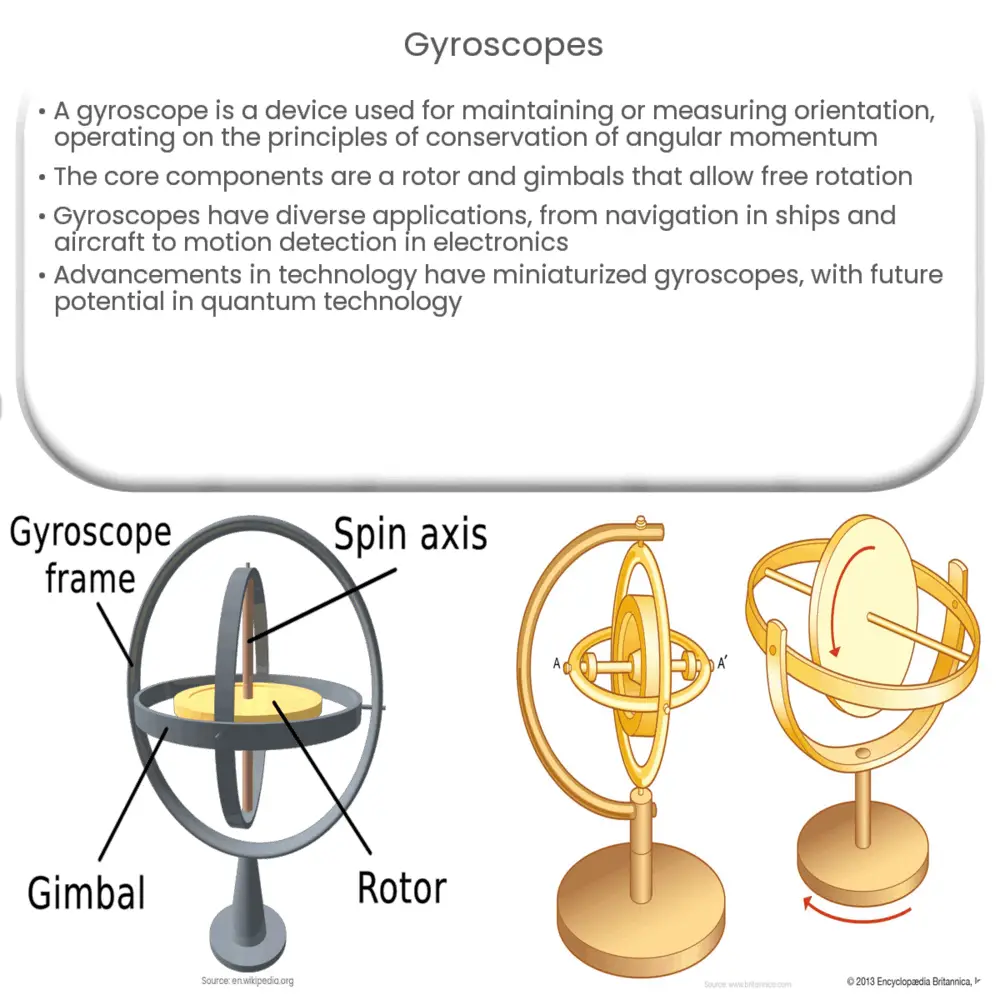Explore the fascinating world of gyroscopes! Learn about their physics, construction, operation, applications, and future trends.

Introduction to Gyroscopes
A gyroscope is a device used primarily for maintaining or measuring orientation and angular velocity. It operates based on the principles of conservation of angular momentum, a concept rooted in classical physics. Essentially, a spinning wheel or disc, mounted in such a way that it can spin freely in any direction or orientation, forms the core component of a gyroscope.
The Physics Behind Gyroscopes
The fundamental physics governing gyroscopes is the principle of conservation of angular momentum. This principle, a cornerstone of Newtonian mechanics, states that the angular momentum of an object or system remains constant unless acted upon by an external torque. This behavior enables gyroscopes to maintain orientation regardless of external influences.
Construction and Operation
- Main Components: The basic gyroscope has two main parts – a rotor and a set of gimbals. The rotor, essentially a spinning wheel or disc, is mounted in the center. The gimbals are rings that encase the rotor, each mounted within the other, allowing the rotor to rotate freely in any direction.
- Operation: The rotor is spun at high speed, often using an electric motor. Once the rotor is spinning, due to the conservation of angular momentum, it will resist changes in its orientation. This characteristic is what makes the gyroscope such a valuable tool in various fields.
Applications of Gyroscopes
- Navigation: Gyroscopes are indispensable in navigation systems, especially those of ships and aircraft. The ability to maintain a constant orientation allows these systems to provide stable and reliable navigational information.
- Electronics: Gyroscopes have found a prominent place in consumer electronics. Devices like smartphones, tablets, and video game controllers often contain small gyroscopes, enabling features such as motion detection and screen orientation changes.
In conclusion, a gyroscope is a versatile tool with a range of applications, from navigation to entertainment. The principles of its operation are rooted in classical physics, and its fundamental design has remained largely unchanged over the years.
Advanced Applications and Developments
In addition to conventional applications, gyroscopes have found utility in more advanced and niche areas:
- Spacecraft: In spacecraft, gyroscopes are critical in maintaining orientation in the vacuum of space, where traditional means of navigation are insufficient.
- Stabilization Systems: Gyroscopic stabilization can be used in various fields ranging from photography, where camera gimbals use gyroscopes to stabilize the camera for smooth video capture, to transportation, where certain motorcycles and monowheels use gyroscopes to maintain balance.
- Medical: In the medical field, gyroscopes are utilized in prosthetic devices and aids for physical therapy, helping patients to regain and maintain balance.
Modern and Future Trends
While the basic design and operation principles of the gyroscope have remained consistent, advancements in technology have led to the miniaturization of gyroscopes. Micro Electro-Mechanical Systems (MEMS) gyroscopes are now commonplace in many electronic devices, providing the same functionality as their larger counterparts in a significantly smaller package.
Looking to the future, the burgeoning field of quantum technology may lead to the next big leap in gyroscope technology. Quantum gyroscopes could potentially achieve unprecedented levels of accuracy and sensitivity, far surpassing the capabilities of current systems.
Conclusion
From guiding ships and aircraft to making our smartphones smarter, the humble gyroscope is a testament to the power and versatility of physics. Born from the principles of angular momentum, it has stood the test of time and technological progress, remaining a fundamental tool in numerous fields.
Despite its long history, the gyroscope is not a static technology. It has evolved, adapted, and grown with each new scientific advancement. And as we move into an era of MEMS and quantum technology, the gyroscope promises to continue to spin, providing orientation and stability in a rapidly changing world.

